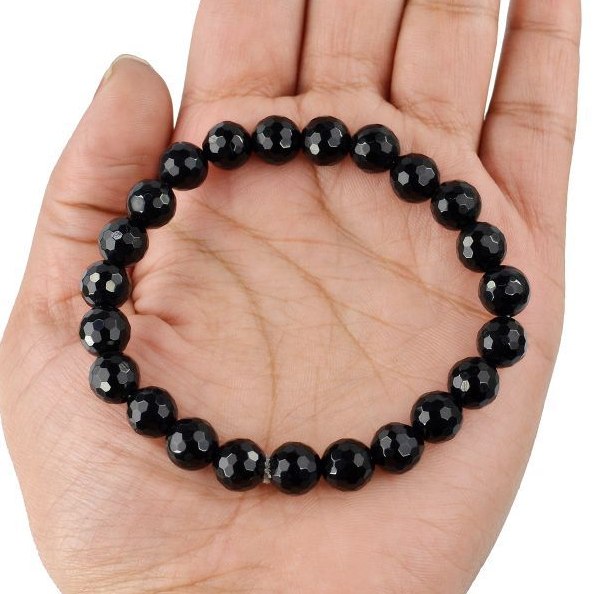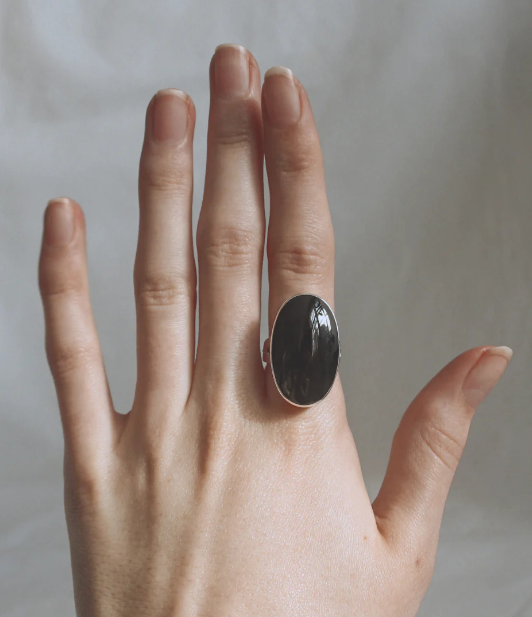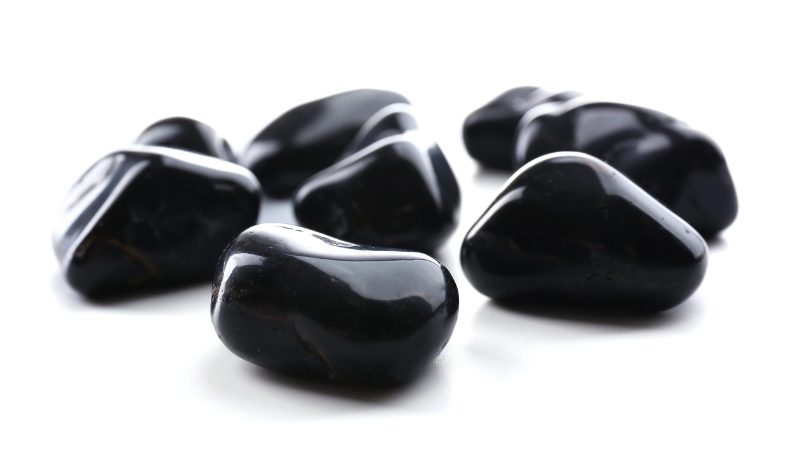In the mesmerizing world of gemstones, the black onyx stands out with its deep, glossy hue and rich history. Revered in ancient civilizations for its believed protective properties and in modern times for its sleek aesthetics, the black onyx has carved a unique space amongst aficionados, collectors, and fashion-forward individuals.
Yet, a question that often arises in the minds of potential buyers and enthusiasts alike is, “How much is a black onyx worth?” Determining the value of a gemstone is influenced by a plethora of factors ranging from its size, quality, and origin to the intricacies of market demand.
This article delves into the nuances of appraising black onyx and sheds light on the elements that dictate its worth. Whether you’re considering adding it to your collection or merely curious about this captivating gemstone, this comprehensive guide is your key to understanding its value.
What Is Black Onyx?
Black onyx is a variant of chalcedony, a type of silica mineral composed of fine intergrowths of quartz and moganite. This captivating gemstone is distinguished by its unique banding, although the bands in black onyx, in particular, are almost uniform, giving it a smooth, deep black appearance.
The formation of black onyx can be traced back to the volcanic lava deposits, where silica-rich solutions solidify under specific conditions to produce this dark and enticing stone.
Symbolism and Historical Significance
With its deep, velvety hue, Black onyx has captivated the imagination of cultures and societies for millennia. The stone’s name itself originates from the Greek word “onyx,” which means “fingernail” or “claw.” It reflects an ancient tale where the goddess Venus had her fingernails cut by Cupid while she slept, with the clippings turning into onyx.
In ancient Egypt, black onyx was believed to have protective properties, with pharaohs and high-ranking officials wearing it as amulets to ward off negative energies. The Romans, too, held the stone in high regard, attributing it with the power to protect its wearer from dark spells and the evil eye. Ancient Roman soldiers often carried engraved onyx amulets as protective talismans in battles.
The Persians and Indians had their own unique beliefs associated with black onyx. They considered it a protective stone, especially during tumultuous times, and believed it to have the power to fend off the evil gaze and deflect negativity.
Usage in Jewelry, Amulets, and Other Ornamental Objects Through the Ages
As we journey through history, the versatility of black onyx in art and adornment becomes evident. In ancient civilizations, this gemstone was meticulously carved into cameos, intaglios, and beads, revealing the stone’s potential as a canvas for intricate designs.
In the Middle Ages, black onyx was frequently set in religious artifacts, adorning various church and cathedral interiors. Its dark hue was often juxtaposed with brighter gemstones to create striking visual contrasts in crowns, scepters, and sacred relics.
The Renaissance period saw a surge in the use of black onyx in jewelry. It became a favorite backdrop for portraits carved in relief, often featuring white onyx layers to create a dramatic two-tone effect. Brooches, rings, and pendants featuring these miniature works of art became immensely popular among the elite.
Fast forward to the Art Deco period of the 1920s and 1930s, and black onyx was once again in the spotlight. Its geometric shapes and contrasting color schemes made it a go-to material for this era’s bold, lavish jewelry styles.
In contemporary times, black onyx retains its allure, often set in silver or gold, and paired with diamonds or other gemstones to craft timeless pieces. Its elegance and versatility have made it a staple in classic and avant-garde jewelry designs.
Factors Influencing the Value of Black Onyx
The value of any gemstone, including black onyx, is determined by a multifaceted matrix of factors. Just as with diamonds, rubies, or emeralds, black onyx’s appeal and monetary worth hinges on several intrinsic and extrinsic criteria. Let’s delve into these decisive elements.
Quality and Grade
1. Clarity: One of the hallmarks of a premium black onyx is its clarity. Unlike other gemstones that can be prized for their inclusions (think of the patterns in turquoise or the lines in tiger’s eye), black onyx is most valuable when free from visible inclusions or defects. A flawless, smooth surface without pits, scratches, or cloudy spots fetches a higher price.
2. Color: A high-quality black onyx boasts a deep, uniform black hue. While slight banding or variation might be present in some stones, the most valuable pieces exhibit consistent coloration without patches of brown or gray.
3. Cut: As with many gemstones, the skill with which black onyx is cut can significantly influence its value. A well-cut onyx will reflect light evenly across its surface and showcase the stone’s deep luster. Precision in faceting and shaping affects the stone’s aesthetics and determines how well it fits into jewelry settings.
Size
Carat Weight and Price: Generally, the larger a gemstone, the more it’s worth, provided the quality remains consistent. However, black onyx is relatively abundant, so the price doesn’t rise exponentially with size as it might with rarer gemstones. Nonetheless, a large, high-quality piece will command a higher price than its smaller counterpart.
A carat of black onyx can range from $1 to $500, depending on its size and quality.
Origin
Source Regions: Black onyx can be found in various parts of the world, including Brazil, India, Madagascar, and the USA.
Regional Prestige: While black onyx doesn’t have as strict regional value differences as some other gemstones, stones sourced from historically renowned mines or regions can sometimes fetch a higher price due to their perceived superior quality or rarity.
Treatment
Natural vs. Treated: Most black onyx in the market today is treated to enhance its color. Naturally, deep-black onyx is rarer and, therefore, often more valuable. Treated onyx is usually dyed to achieve a consistent black shade. While it can still be beautiful and durable, purists and collectors might value natural onyx higher.
Current Market Demand
Jewelry Industry Trends: The popularity of black onyx in jewelry can ebb and flow based on current fashion trends. When designers and jewelers feature black onyx in their collections, demand can surge, leading to higher prices.
Pop Culture Influence: Gemstones can become popular due to celebrity endorsements or appearances in movies and TV shows like clothing or hairstyles. If Black Onyx gains visibility in pop culture, its demand and value can increase.

Comparing Black Onyx with Other Gemstones
Gemstones are as varied as the cultures that cherish them. Their worth is derived not just from their rarity, but also from their history, cultural significance, and the emotional value they hold. In the vast spectrum of gemstones, how does black onyx compare?
How its Value Stands in Relation to Other Popular Stones
When we think of valuable gemstones, diamonds, emeralds, sapphires, and rubies often come to mind. These stones, particularly in their high-quality forms, can fetch astronomical prices, with their worth calculated not just in carats but in the stories they’ve been a part of and the hands they’ve passed through.
While holding its own in terms of beauty and utility, Black Onyx is generally more affordable than these high-end gems. Its relatively abundant availability plays a role in this. However, it’s essential to remember that while diamonds and their kin might rule the roost in terms of price tags, value is subjective.
For someone drawn to the deep allure of black onyx or someone who believes in its metaphysical properties, this gemstone’s value might surpass even the rarest diamond.
Specific Attributes That Make it Unique or Coveted
Deep Black Hue: Few gemstones can match the intense and consistent black of the onyx. This makes it a favorite for contrast in jewelry, especially when paired with brighter stones or metals.
Versatility: Its uniform color and shape and polish ability make black onyx a favorite for various jewelry styles, from classic to contemporary.
Symbolism: Beyond its physical attributes, black onyx has a rich tapestry of symbolic associations. Many cultures revere it for its protective properties and ability to ground and stabilize emotions.
Durability: Black onyx, with its decent hardness, stands up well to wear and tear, making it a good choice for everyday jewelry.
Affordability: Black onyx offers the perfect solution for those seeking a stylish yet budget-friendly gemstone. Its relative affordability doesn’t detract from its beauty, making it an excellent choice for those wanting elegance without the hefty price tag.
Uses and Applications
With its lustrous dark hue, the enigmatic black onyx has intrigued and enchanted civilizations. Its utility extends beyond aesthetics, permeating artistic, decorative, and spiritual realms. Here’s a deeper look into this captivating stone’s various uses and applications.
Black Onyx in Jewelry: Rings, Necklaces, and Earrings
1. Rings: The consistent hue of black onyx makes it a favored choice for statement rings. The gem stands out, often encased in gold or silver settings, exuding sophistication and class. From solitaire designs to more elaborate configurations paired with diamonds or colored gemstones, black onyx rings are a testament to timeless elegance.
2. Necklaces: Whether a pendant showcasing a singular, polished piece of black onyx or a string of onyx beads, necklaces featuring this stone are versatile and fit seamlessly with formal and casual attire.
3. Earrings: Black onyx earrings, like studs, drops, or hoops, offer a touch of intrigue to the wearer. Their inherent elegance can uplift any outfit, making them a staple in many jewelry collections.
Its Role in Artistic and Decorative Objects
Throughout history, the malleability and the striking color of black onyx have made it a favorite medium for artisans:
1. Sculptures: Miniature to life-sized sculptures have been carved from black onyx, capturing the intricacies of the subjects they depict.
2. Vases and Utensils: The allure of black onyx has been harnessed in creating decorative vases, bowls, and other utensils, often seen gracing opulent settings.
3. Inlays: Black onyx has been used in intricate inlay work, especially in luxury furniture pieces, where its dark tone creates beautiful contrasts with wood or other materials.
Significance in Metaphysical and Spiritual Practices
Beyond its tangible beauty, black onyx holds a reservoir of spiritual significance:
1. Protection: Historically, many cultures believed in the protective aura of black onyx, wearing or keeping it to ward off negative energies and potential harm.
2. Grounding: Metaphysical practitioners often regard black onyx as a grounding stone, believed to anchor erratic energies and stabilize fluctuations.
3. Emotional Healing: Some spiritualists consider black onyx to have healing properties, aiding in the recovery from emotional traumas and fostering resilience and strength.
4. Meditation: Due to its grounding properties, black onyx is also used as a meditation aid, helping individuals center their energies and heighten their focus.
In wrapping up this section, it’s evident that black onyx’s worth is not just tied to its monetary value. Its wide array of uses and profound symbolic resonance across cultures underscores its enduring appeal, making it much more than just a piece of stone.

Buying and Selling Tips
Navigating the gemstone market can be daunting, especially with the myriad options available and the looming threat of imitations. With black onyx gaining popularity, buyers and sellers must be equipped with the knowledge to make informed decisions. Let’s delve into some key tips for both sides of the transaction.
How to Tell if Black Onyx is Real
With its rich history and timeless allure, Black onyx is a coveted gemstone in various applications, from jewelry to spiritual practices. As its popularity soars, so does the market for imitations and synthetics. Knowing how to distinguish genuine black onyx from fakes is crucial for the discerning buyer. Here are more detailed insights into the methods you can use to verify the authenticity of black onyx.
Texture and Temperature
- Initial Feel: When you first touch a piece of genuine black onyx, you’ll notice it feels cool — noticeably cooler than the ambient temperature. This coolness is a characteristic of many natural gemstones and is due to their ability to conduct heat away from your skin quickly.
- Warming Rate: If you hold the stone in your hand, genuine black onyx will take time to warm up. Imitations, especially plastic ones, will adapt to your body temperature more quickly.
Scratch Test
- Hardness: On the Mohs scale of mineral hardness, onyx falls between 6.5 and 7. This makes it relatively hard and resistant to scratches.
- Conducting the Test: Take a sharp object, like a pin or a pocket knife, and try scratching the stone discreetly in an inconspicuous area. If it’s genuine, the stone will resist minor scratches. However, always approach this test with caution to avoid damaging the stone or diminishing its value.
Translucency Test
- Characteristics of Genuine Onyx: Although black onyx is predominantly opaque, it can display subtle translucency when cut thinly.
- Conducting the Test: If you have a thin slice or a particularly slender piece of what you believe is black onyx, hold it up to a light source. If you observe a faint glow or translucency around the edges, it’s a positive sign. However, remember that thicker cuts might not exhibit this trait as noticeably.
Consult a Gemologist
- Expertise Matters: While at-home tests provide a good starting point, they could be more foolproof. A certified gemologist or a trusted jeweler has specialized tools, like a refractometer or a spectroscope, and the experience to identify gemstones accurately.
- Certifications: When buying from a dealer, always inquire about certifications. A certificate from a reputable gemological institute can provide details about the gemstone’s origin, treatments (if any), and authenticity.
Tips for Potential Buyers: Ensuring Fair Pricing and Quality
Research the Market: Before making a purchase, get a feel for the current market rates of black onyx based on its quality, size, and origin.
Ask for Certifications: Reputable dealers often provide certifications that attest to the gemstone’s authenticity and quality.
Examine the Stone: Look for uniformity in color, check for visible flaws or inclusions, and ensure the cut and polish meet your expectations.
Buy from Reputable Dealers: Always opt for dealers with good reviews and established credibility in the market.
For Sellers: How to Present and Market Black Onyx Effectively
Highlight the Stone’s Origins: If your black onyx comes from a location with historical or cultural significance, use that as a selling point.
Professional Photography: High-quality images that capture the stone’s luster and depth can significantly attract potential buyers.
Transparency is Key: Clearly mention if the black onyx is treated or natural. Honesty builds trust and credibility with customers.
Educate the Buyers: Provide potential buyers with information about the stone’s properties, care instructions, and its historical and metaphysical significance.
Leverage Social Proof: Showcase reviews or testimonials from previous buyers to build confidence among potential customers.
In the end, knowledge is your most valuable asset whether you’re looking to buy or sell black onyx. Being well-informed ensures a fair transaction and heightens appreciation for this enigmatic gemstone.
Future Projections
In the world of gemstones, black onyx has been a steady presence, admired for its beauty, symbolic significance, and versatility. As we look ahead, certain market dynamics and trends could shape its future demand and value. Here’s a speculative glance at what might lie in store for black onyx.
Predictions About the Future Market and Demand for Black Onyx
1. Rising Popularity in Contemporary Jewelry: As minimalist and monochrome styles continue to trend in the fashion world, black onyx, with its sleek and versatile appearance, is poised to gain further traction, especially among younger consumers.
2. Increased Demand in Emerging Markets: With growing economies and a burgeoning middle class, regions like Asia and Africa might develop a heightened interest in gemstone jewelry, including black onyx pieces.
3. Spiritual and Wellness Trends: As more people turn to spirituality, meditation, and healing crystals for mental well-being, the metaphysical properties associated with black onyx could spur its demand.
4. Synthetic and Treated Black Onyx: Advances in gemstone treatments and the production of synthetic stones could lead to an influx of high-quality, lab-made black onyx, making it more accessible but potentially affecting the value of natural black onyx.
Potential Factors That Could Influence Its Value in the Coming Years
1. Mining and Accessibility: Any disruptions in the mining regions, whether due to political unrest, environmental concerns, or reduced accessibility to resources, can directly impact the supply and, consequently, the price of black onyx.
2. Environmental and Ethical Considerations: As consumers become more environmentally conscious and ethical in purchasing, sustainably mined and ethically sourced black onyx might command a premium.
3. Cultural and Pop Influences: The popularity of gemstones can sometimes be influenced by their portrayal in popular culture, movies, or celebrity endorsements. A high-profile appearance or association can lead to short-term spikes in demand and value.
4. Technological Innovations: Advancements in gemstone treatments and crafting techniques might make producing more visually appealing black onyx pieces easier, influencing their value and demand.
5. Global Economic Factors: Economic downturns or booms can impact discretionary spending. Luxury items, including gemstones like black onyx, can be influenced by macroeconomic factors.
While black onyx’s inherent beauty and allure are unlikely to wane, its market dynamics will be shaped by a confluence of cultural, economic, technological, and environmental factors. For potential investors, collectors, or enthusiasts, staying attuned to these trends and developments will be crucial in understanding the gemstone’s evolving worth.
Conclusion
Understanding the worth of black onyx is much like peering into the gemstone itself – layered, profound, and intriguing. As we’ve delved into its historical context, varied applications, market dynamics, and future projections, it’s evident that the value of black onyx is multifaceted.
In the vast universe of gemstones, each has its story and allure. With its enigmatic charm, Black Onyx has carved a niche for itself. Its allure is not just in its appearance but in its depth of meaning and significance across cultures and ages.
As trends come and go, the value of certain items may fluctuate, but true worth often withstands the test of time. Black onyx stands as a testament to this. Whether you’re a collector, investor, or simply appreciate the beauty of gemstones, black onyx reminds you of the timeless bond between nature’s wonders and human admiration.
Something is reassuring about the constancy of black onyx’s appeal in a world constantly in flux. Its place in the gemstone world is not just about its market price but also its rich tapestry of stories, symbolism, and the sheer beauty it brings into our lives.



